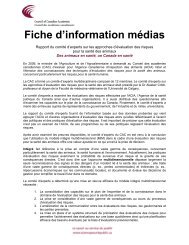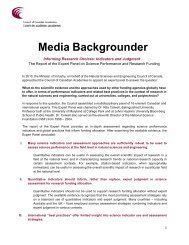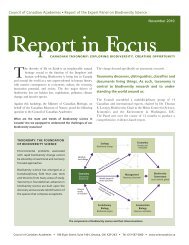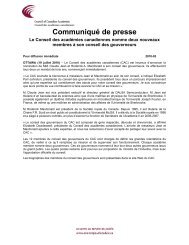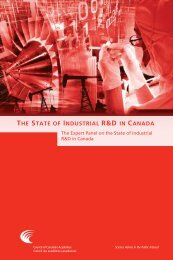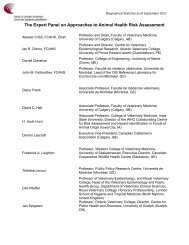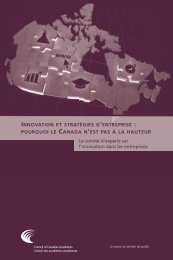an assessment of the evidence - Council of Canadian Academies
an assessment of the evidence - Council of Canadian Academies
an assessment of the evidence - Council of Canadian Academies
- No tags were found...
You also want an ePaper? Increase the reach of your titles
YUMPU automatically turns print PDFs into web optimized ePapers that Google loves.
22 Influenza Tr<strong>an</strong>smission <strong>an</strong>d <strong>the</strong> Role <strong>of</strong> PPRE: An Assessment <strong>of</strong> <strong>the</strong> EvidenceThe thoracic region is defined as <strong>the</strong> tracheobronchial <strong>an</strong>d alveolar regionscombined (Figure 3).Upper Respiratory TractPharynx (throat)Larynx (voicebox)Trachea (windpipe)Right lungBronchusBronchiolePleuraDiaphragm(breathing muscle)TracheobronchialRegionImage not availableHeartBr<strong>an</strong>ch from <strong>the</strong>pulmonary vienLeft lungBronchioleBr<strong>an</strong>ch from <strong>the</strong>pulmonary arteryBlood CapillariesAlveoliPulmonary RegionFigure 3Anatomical regions <strong>of</strong> <strong>the</strong> respiratory tract(Fig. 38.22 p.839 from BIOLOGY, 3rd ed. byNeil A. Campbell. Copyright © 1987, 1990, 1993 by <strong>the</strong> Benjamin/CummingsPublishing Comp<strong>an</strong>y, Inc. Reprinted by permission <strong>of</strong> Pearson Education, Inc.)A person emits respiratory particles in a wide r<strong>an</strong>ge <strong>of</strong> sizes. Where particles aredeposited in <strong>the</strong> respiratory tract <strong>of</strong> <strong>the</strong> potential host depends primarily on <strong>the</strong>irsize (Nicas, 1995; Vincent, 1990; Sattar, 1987; Lippm<strong>an</strong>n, 1980; Stuart, 1976).While <strong>the</strong> size delineations for each category serve as effective discussion tools forpl<strong>an</strong>ning purposes, it is import<strong>an</strong>t to note that, in actuality, particle behaviors fallalong a continuum.• Alveolar-sized particles are less th<strong>an</strong> approximately 10 µm in diametre. Theyare <strong>the</strong> only particles capable <strong>of</strong> reaching <strong>the</strong> alveolar region but c<strong>an</strong> bedeposited <strong>an</strong>ywhere in <strong>the</strong> respiratory tract.• Tracheobronchial-sized particles have a diametre <strong>of</strong> approximately 10 to 20 µm.They are capable <strong>of</strong> depositing as far down as <strong>the</strong> tracheobronchial region.• Nasopharyngeal-sized particles are from approximately 20 to 100 µm in diametre.They tend to travel no fur<strong>the</strong>r th<strong>an</strong> <strong>the</strong> upper respiratory tract.• Ballistic particles have a diametre greater th<strong>an</strong> approximately 100 µm. They c<strong>an</strong>be deposited directly onto mucous membr<strong>an</strong>es but have a low probability <strong>of</strong>being inhaled.





